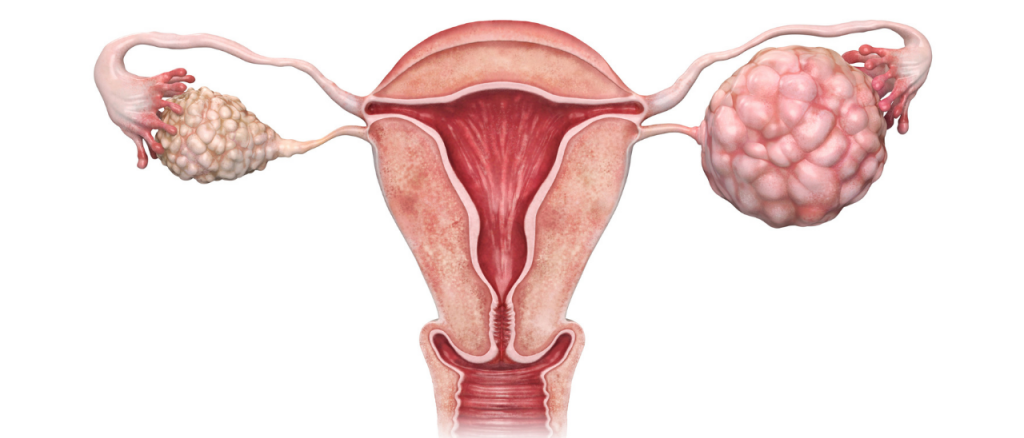INTRODUCTION
PCOS is a hormonal condition in women who present with irregular menstrual cycle, excessive male pattern of hair and enlarged ovaries.
It affects about 10 % of women in their reproductive age group. These women usually have other conditions such as diabetes mellitus.
SYMPTOMS
Most women with PCOS notice symptoms during their first menstrual cycle. Symptoms include the following:
- Abnormal menses
Some women menstruate at intervals of 35 days to 6 months or more. In some cases, there are no menses for up to 6 months. This usually occurs as a result of chronic anovulation [lack of ovulation in the woman].
- Excessive androgen production
Androgens are essentially male hormones and they manifest as excessive male pattern of hair distribution around the chin, chest, nipples, and abdomen. Some also have voice change and hair loss.
- Overweight
Most women with PCOS are obese and about 10% of them are diabetic
- Polycystic ovaries
The lady has an increase in ovarian volume, with small immature follicles that usually fail to ovulate.
CAUSES
The cause of PCOS is unknown. Some of the reasons why a lady may develop PCOS include:
- Insulin resistance
Insulin is produced by the body to allow the body cells to utilize glucose. If the body becomes resistant to it, the blood glucose will increase and the pancreas will produce more insulin hoping to utilize the increased load of glucose. An increase in insulin production increases androgen production, which may prevent ovulation.
- Excessive androgen production
Women with PCOS have an increased level of luteinizing hormone (LH) which stimulates the ovarian theca cells to increase the production of androgens. These androgens cannot be converted to estrogen leading to decreased estrogen levels and lack of ovulation.
PREVENTION
PCOS cannot be prevented. However, its effect can be reduced by doing the following:
- Living an active life
This helps reduce blood sugar levels and the risk of diabetes. It also helps maintain a healthy weight thus reducing insulin levels and restoring ovulation.
- Healthy eating habit
Eating food low in carbohydrates can help reduce insulin levels.
COMPLICATIONS
PCOS could lead to the following:
- Infertility
This occurs as a result of chronic anovulation.
- Type 2 Diabetes Mellitus
This occurs as a result of insulin resistance.
- Endometrial cancer
This occurs as a result of chronic anovulation and several months of a woman not menstruating. Lack of menstruation increases the risk of endometrial hyperplasia and cancer.
DIAGNOSIS
Two of the three parameters are necessary to diagnose PCOS. They include:
- Abnormal menses
- Hyperandrogenism [evidenced by androgen excess e.g. testosterone]
- Polycystic ovaries [Ultrasound scan diagnosis]
Laboratory examination done may include:
- Testosterone is usually elevated.
- DHEA-S is usually normal or high.
- Blood glucose might be elevated.
A transvaginal scan may be useful in picking up the polycystic ovaries describes as 12 or more follicles in at least 1 ovary measuring 2-9 mm in diameter or a total ovarian volume of >10 cm3.
TREATMENT
When a doctor makes a diagnosis of PCOS, the client will be counselled on lifestyle modifications and the need for medical or surgical intervention.
Lifestyle modification
This involves reducing carbohydrate intake and exercising regularly to reduce weight. Thirty [30] minutes of walk daily is recommended. Losing 5 – 10 % of body weight could help restore ovulation.
Medical Treatment
- Regulation of menses
This can be achieved with the use of oral contraceptive pills containing estrogen and progesterone. Hence, women menstruate monthly reducing their risk of endometrial cancers. The use of progestin medications such as minipills or Mirena has a similar effect in regulating the menses.
- Regulation of ovulation
For women who wish to get pregnant several drugs are used to help induce ovulation. These drugs are first-line treatment for women who wish to get pregnant. They include:
- Metformin [Glucophage]. Originally used to treat diabetes, it is known to lower insulin levels and reduce androgen production. About 50% of women will ovulate while using it.
- Clomid [Clomiphene citrate]. It is an antiestrogen that blocks the effect of estrogen in the ovaries and increases follicle-stimulating hormone which helps with ovulation.
- They are injectable medications that stimulate the ovaries to produce eggs.
- Reduction of excessive hair
Excessive hair can be removed using shaving creams or laser treatment.
Medications that can reduce excessive hair growth include oral contraceptive pills [reduces androgens secretion], spironolactone [an androgen]. There are several other medications for sale that are effective.
Surgery
This may become necessary in some cases where medications are not able to restore ovulation.
Laparoscopic ovarian drilling is the treatment of choice as it is minimally invasive and reduces the risk of adhesions among other benefits.
WHEN TO SEE A DOCTOR
You are advised to see your doctor if you experience the following.
- If you are not able to get pregnant
- If you have challenges with your menstrual period
If you have a male pattern of hair distribution on your face and body

